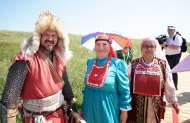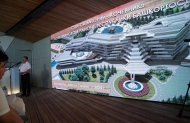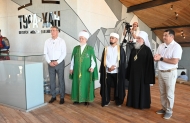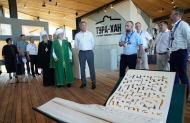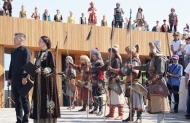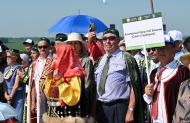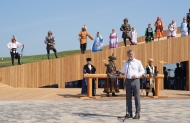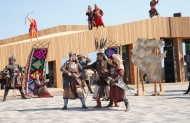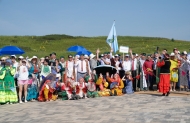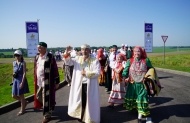
The visit centre of the Eurasian Museum of Nomadic Civilizations was opened in Bashkiria's Chishma District near the Tura Khan Mausoleum. The solemn ceremony was attended by the Head of the Republic of Bashkortostan Radiy Khabirov, Chairperson of the General Council of the Eurasian Peoples’ Assembly Svetlana Smirnova, delegates of the State Assembly - Kurultai of the Republic of Bashkortostan, federal politicians and representatives of public organizations.
The ancient mausoleum of Tura Khan is one of the most important sacral places and historical monuments of the Republic of Bashkortostan. The lands of the present Republic were one of the centers of nomadic civilization from the Golden Horde and the Great Migration of Peoples, when the Bashkir ethnos and many peoples of the Eurasian space were formed. Tura-Khan was a descendant of Genghis Khan, his possessions were in Siberia, then with his entire horde of 80 thousand kibits he travelled to Ufa and became its ruler.
At the opening ceremony of the visit centre of the Eurasian Museum of Nomadic Civilizations, the Head of the Republic of Bashkortostan Radiy Khabirov stressed the commonality of the ethnogenesis of the Eurasian peoples. Most of the continent from Japan to Hungary is inhabited by descendants of ancient nomads from the east and south. The Mausoleum of Tura Khan is the most important centre of history and culture, a base for scientific and archaeological research and a place of mass tourism.
The opening of the centre in Chishminsky district, a few kilometers from Ufa, was attended by distinguished guests, politicians and public representatives from Mongolia, Kyrgyzstan, Kazakhstan, Uzbekistan and Russian regions. Rifkat Minnikhanov, President of the Academy of Sciences of the Republic of Tatarstan, emphasized the link between times and peoples, which connects the fabric of the Eurasian space.
Radiy Khabirov said that the opening of the Eurasian Museum of Nomadic Civilisations is the beginning of a large scientific project to create Russia's largest historical and cultural centre for the study of nomadic civilization. The head of the republic stressed the historical significance of the centre for the consolidation of the Bashkir ethnos and the important role of nomadic peoples in the development of Eurasia. The museum was presented with significant exhibits - a copy of the Ostromir Gospel and a handwritten copy of the 7th century Koran of Osman.
The visit centre will serve as a public space with an exposition with reconstructions, copies of artefacts related to the history of Islam and nomadic culture of the Ural-Volga region. It is a public space of 650 square metres, including a 620-meter-long pedestrian eco-trail leading to the mausoleum itself, bypassing the burials discovered here. The prologue of the open-air exposition "The Way of the Nomad" is the columns of the facades of the Visitor Centre building decorated with ornaments of Turkic and Mongolian peoples.
In the museum one can get acquainted with the exposition telling about the peculiarities of architecture of medieval tombs, see the reconstruction of the necropolis adjacent to the mausoleum, as well as the restored appearance of those buried in the mausoleum of Hussein bey. To give visitors an idea of the scale of the Mongol Empire, a detailed map of Steppe Eurasia with the borders of states and localization of ethnic groups in the XIII-XV centuries is presented. There are also replicas of archaeological artefacts from the period of the Golden Horde, found during research on the territory of Bashkortostan. They prove the fact that in the XIV-XV centuries this territory was a significant administrative unit of the Golden Horde, developed in economic terms.
A significant part of the Visitor Centre's exposition is devoted to the history of the Bashkir people. For example, an exact copy of Akhmad ibn Fadlan's manuscript of the 10th century containing the first written mention of the Bashkirs, a copy of Mahmud Kashgari's map of the 11th century with the localization of the Bashkir people on it, as well as the shezheres of the leader of the Bashkir tribe Min Kanzafar-biy. According to Alexander Kobyskan, a senior researcher at the Centre for Socio-Cultural Analysis of the Institute of Strategic Studies of the Academy of Sciences of the Republic of Bashkortostan, the new museum is a logical continuation of the Shulgan-Tash Historical and Cultural Museum-Reserve in the Burzyan district, where cave drawings from the Paleolithic era have been preserved.
Senator from Bashkortostan Lilia Gumerova congratulated the residents on the opening of the museum complex, which will become a point of attraction for tourists. The most important meanings of the past and present of the Eurasian peoples are united here, this is an important integration value for all peoples, emphasized Svetlana Smirnova, Chairperson of the General Council of the Eurasian Peoples’ Assembly. Director of ANO "Eurasian Centre of Equestrian Traditions" Oksana Zhavoronkova also highlighted the discourse of development of the Eurasian civilization, successfully formed thanks to the equestrian nomadic peoples of antiquity and early Middle Ages.
In the photo gallery - the opening celebration.





